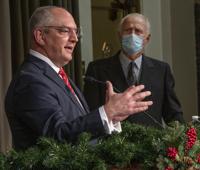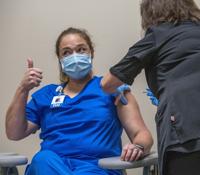Louisiana this week received highly-anticipated recommendations from the federal government for who should be next in line for the vaccine, after hospital workers and those who live and work at long-term care facilities like nursing homes.
It may have produced more questions than answers.
About 40% of COVID-19 deaths in U.S. have come in nursing homes, similar settings
Next in line after the first phase, which is underway, should be front-line essential workers like first responders, corrections officers, food and agriculture workers, U.S. Postal Service workers, manufacturing workers, grocery store workers, public transit workers and school personnel like teachers and support staff, as well as child care workers, according to the guidance. In addition, people aged 75 years or older should be included, because of their likelihood to be hospitalized or die from COVID-19.
After that are people aged 65 and older, people with a list of underlying health conditions that increase their risk from the virus and other essential workers, like those in transportation and logistics, water and wastewater, food service, construction, bank tellers, information technology and communications, energy, media, legal, public safety and public health workers.
In all, the U.S. Centers for Disease Control and Prevention, or CDC, estimates about 178 million people are included in those phases. By comparison, 24 million across the country are estimated to be in the first group being vaccinated now.
The guidance leaves Louisiana with a host of ethical and logistical questions to answer as the vaccine production continues to ramp up. That process is made more difficult by the fact that a large share of Louisiana’s population has the underlying health conditions the federal government says should qualify people for vaccination. Those include people with cancer, chronic kidney disease, chronic pulmonary disease, heart conditions, weakened immune systems, obesity, sickle cell disease, type 2 diabetes and smokers.
“It’s easy to see where a quarter of our state's population could call into one priority group,” Gov. John Bel Edwards said at a Tuesday press conference. “You just can’t administer the vaccine quickly to that many people.”
Louisiana’s priority groups will not look “markedly different” from what the CDC’s advisory panel, called the Advisory Committee on Immunization Practices (ACIP), recommended, Edwards said.
VATICAN CITY (AP) — Pope Francis made a Christmas Day plea for authorities to make COVID-19 vaccines available to all, insisting that the firs…
But the huge number of people who potentially fall into the next phases leaves the Edwards administration with the task of spelling out in greater detail who will be next in line.
The process won’t be like a “light switch,” Edwards said. While 200,000 to 215,000 people are included in the first phase, not everyone will take advantage of the vaccine. And the vials can’t last forever at room temperature. As a result, the governor said the state has already started vaccinating some people with end-stage renal disease, who receive regular dialysis treatments, to avoid wasting doses.
Dr. Joe Kanter, head of the coronavirus response at the Louisiana Department of Health, said he didn’t yet have a good read on how many hospital workers offered the vaccine and refused it so far.
“The X-factor is how many people are going to show up on day one or day two to get the vaccine,” Kanter said. “That’s sometimes challenging to plan for.”
Another challenge, Kanter agreed, is that many Louisianans have underlying health conditions that make them more susceptible to COVID-19, and as such were prioritized by ACIP.
Edwards’ administration had received about 100 requests from associations, businesses, lobbyists and state agencies seeking vaccine priority for their workers or clients. Judges at the state and federal level also asked to be near the front of the line for the vaccines.
The governor specifically pointed to data that show people who are older are far more likely to die from COVID-19 than people in the 18-29 age group. People aged 60-69 are 64 times more likely to die; people 70-85 are 199 times more likely and people 85 and older at 667 times more likely to die from the disease, Edwards said.
“Those are staggering numbers,” Edwards said. “And those are some of the numbers by the way that are informing our decisions on vaccinations.”
Essential workers like police and grocery store workers should be prioritized too.
Dr. Susanne Straif-Bourgeois, associate professor of epidemiology at LSU Health Sciences Center New Orleans, said she agrees it could be more difficult for Louisiana to wade through the federal recommendations given the state’s outsized share of people with health conditions. She also noted that people with underlying conditions will likely overlap quite a bit with the preceding groups, like essential workers, the elderly and nursing home residents.
“And the problem is how to reach this population like through specialty clinics or providers?” Straif-Bourgeois said in an email. “And what about persons who don’t have easy access to healthcare? It will be very difficult to reach that population.”
Louisiana crafted a vaccine playbook earlier this year that spelled out when people would have access to the vaccine, depending on the availability of the doses, people’s occupation and whether they are more at risk from the disease. But the governor has said he will tweak the plan to bring it in line with federal recommendations as they come down.
Aly Neel, a spokeswoman for the Louisiana Department of Health, said Wednesday the agency didn’t yet know how many people fall into the Phase 1b and Phase 1c priority groups outlined by the feds.
The state is expected to tap pharmacies across the state and other providers to help immunize people once the vaccines become more widely available. So far, Pfizer’s vaccine, which needs to be stored at extremely low temperatures, has largely gone straight to large hospitals to vaccinate workers there. Moderna’s vaccine is set to be distributed to nursing homes and other long-term care facilities to vaccinate staff and residents starting Dec. 28th. That is through a federal partnership with CVS and Walgreens.
The first two weeks of shipments are slated to bring more than 146,000 doses to Louisiana. Next week, Kanter said the state expects 36,075 more doses of Pfizer’s vaccine and 27,500 doses of Moderna’s vaccine. That will bring the total to more than 210,000. There are roughly that many people included in the first phase, but not everyone in that group is expected to get vaccinated, and those who do will require two doses weeks apart.
“We’re going to get beyond the tier 1 hospital workers as quickly as we can,” Edwards said, but he added he doesn’t have a “precise timeline.” It depends largely on how quickly doses flow to Louisiana.
The state initially was told to expect 40,000 doses of Pfizer’s vaccine in the second week’s shipment, but that was revised downward to under 29,000 in what the Trump administration official in charge of vaccine distribution called a “miscommunication” with several states who saw their shipment revised downward.
WASHINGTON (AP) — The U.S. added a second COVID-19 vaccine to its arsenal Friday, boosting efforts to beat back an outbreak so dire that the n…
Along with having trouble getting enough doses quickly, the governor noted many people may be hesitant to take the vaccine. Some people are against all vaccinations, he noted, while others dismiss the seriousness of COVID-19.
Plus, “we have to be honest,” Edwards said, “African Americans have not been treated well historically as it relates to medical science.” He said he’s working with federal, local and health leaders to communicate to people who are hesitant to get vaccinated that the vaccines are safe and effective.
“At the end of the day we need to get to at least 70% of the people of Louisiana” immunized to reach herd immunity, he said.
The state has laid out a tentative plan to prioritize vaccinations to certain groups based on risk of exposure, risk of transmitting to others…
"who" - Google News
December 27, 2020 at 06:00AM
https://ift.tt/3pjVz34
Who's next in line for Louisiana's coronavirus vaccine after Phase 1 rollout? It's complicated - The Advocate
"who" - Google News
https://ift.tt/36dvnyn
https://ift.tt/35spnC7
Bagikan Berita Ini

















0 Response to "Who's next in line for Louisiana's coronavirus vaccine after Phase 1 rollout? It's complicated - The Advocate"
Post a Comment